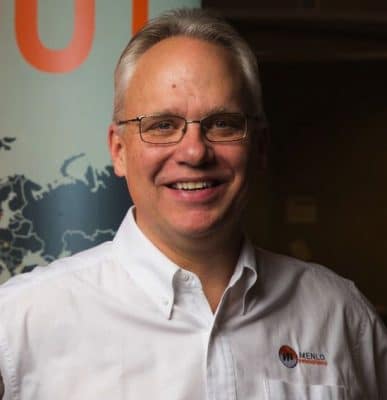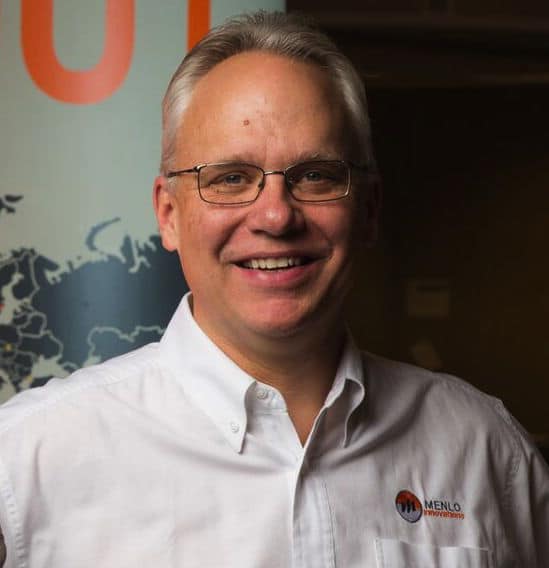By Dan Cook
You can’t spend much time around Rich Sheridan without feeling the ground shake under you. He’s got his own ideas about how a business should be run and, frankly, some of his practices and theories fly in the face of the tech world’s norm.

Take, for instance … Well, where to start with Sheridan’s maverick ideas? An introduction might help.
Sheridan, who will be a keynote speaker at PNSQC 2017 this October, jumped ship after years in the “traditional” tech world and, in 2001, co-founded Menlo Innovations in Ann Arbor, MI. In 2013, he wrote a book (Joy Inc.: How We Built a Workplace People Love) that describes his journey and the founding of Menlo Innovations.
Basically, he said he lost his passion for tech, a passion that surfaced at age 13, only to slowly be extinguished by bureaucratic thinking, practices and policies mired in the past, and the joyless pursuit of the dollar instead of excellence.
When he co-founded Menlo with James Goebel and Robert Simms, the trio created a blueprint for a completely new way to run a tech company. Among key differences between Menlo and most tech firms:
- The company was and is headquartered in Ann Arbor, MI, far from any major tech cluster.
- Employees work in a completely open environment: No offices, no permanent work stations, no walls, no partitions.
- Employees work in pairs that are regularly reshuffled. Menlo has no all-star developers; everyone is paired all the time.
- Employees come into the office every day, work eight hours, and then stop working. They are not expected to work outside the office. (Sheridan says there are occasional exceptions to this rule but this is the expectation.) In other words, Menlo isn’t interested in folks who prefer to work remotely.
- New employees are interviewed by a team of current employees. As many as 50 may be interviewed in an unusual two hour event.
- Customers have weekly check-ins with the team working on their project. Some customers actually come to the Ann Arbor office for these sessions.
This isn’t an exhaustive list by any means of the differences one finds at Menlo compared to most other tech firms. But you get the idea.
I asked Sheridan if the parameters wouldn’t make it difficult to recruit those coveted millennials that everyone is studying and writing about these days.
“My impression is that all ages either prefer our work style or they don’t,” he said. “Our interview process makes the expectations very clear. Thus, there is no negotiation around these points. I’d guess we don’t see any trouble because we make this requirement so obvious.”
The point of all those idiosyncratic practices and rules is, Sheridan says, to bring joy to the workplace. For instance, the eight-hour day, with no “homework,” rule was intentionally established to bring joy to the employee and joy to the customer.
“We don’t encourage people to work remotely,” he said. “Our expectation is that when you walk out the door you are done. Your eight hours are over. You don’t go home and work. Joy for us is delighting the clients with great software. We believe tired people make bad software. And tired employees are not joyful.”
A key element to Menlo’s success is the company’s dedication to quality assurance and testing — another area where Menlo fiercely defies the industry norm.
“Nobody sticks up for QA people, but I will!” he said with obvious passion. “You know what life is like for QA: You get something months after it’s done. You start testing, you can’t even get it to build, let alone run, let alone run correctly. And what does the developer tell you when you say, ‘Hey Bill, the code doesn’t seem to work.’? Bill says, ‘It worked on my machine.’”
His objective: To “elevate the QA team to quality advocacy, not quality assurance. Not testing quality into the system but literally testing for design and customer intent. Because the software they receive would actually works! Our programmers cannot turn over the code to the QA team until all the automated tests work. QA is testing at a very very high level [at Menlo]. Less than 10% of hours on a project are testing, and we have not had a single software emergency since 2004.”
Is Menlo Innovations, then, the Nirvana/the Promised Land/the Shangri-la for software testers? You’d have to get up and go to an office every day. You’d have to share a computer screen with your partner. You’d have to be willing to help with the mass interviews, live in Michigan where it snows A LOT in the winter, learn to live without a permanent work station, and get used to a bunch of other Menlo cultural artifacts that successful Menlonians learn to adopt.
In exchange, you’d be part of a team where you build software that not only works but, as Sheridan said, “Delights!” Perhaps more important, the people at the top respect and believe in you! And pay you the same as developers!
You might want to have that resume updated when Rich Sheridan comes to town for PNSQC 2017.




